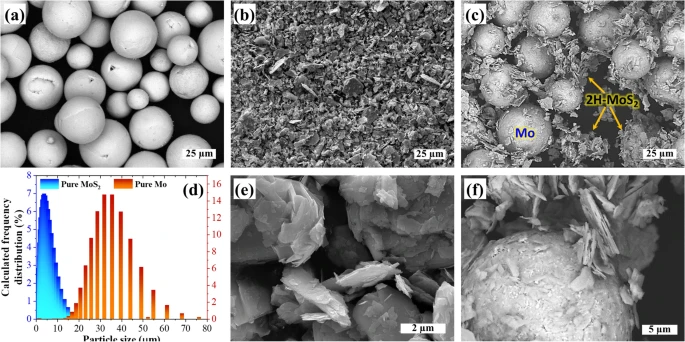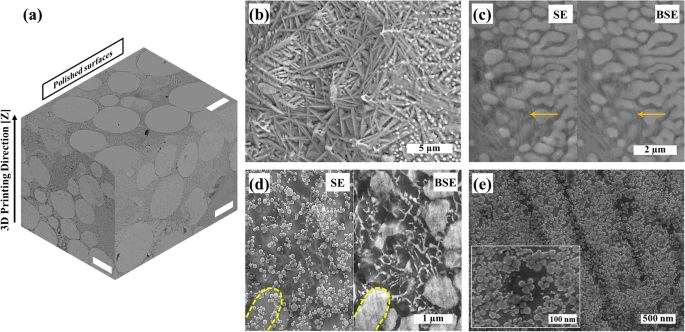Researchers have published an article in Scientific Reports in which they have focused on selective laser melting (SLM) employed efficiently to enhance the performance and crystallographic characteristics of molybdenum disulfide (MoS2).

Study: SLM-processed MoS2/Mo2S3 nanocomposite for energy conversion/storage applications. Image Credit: GiroScience/Shutterstock.com
What is Selective Laser Melting?
SLM is a 3D printing process that uses a high power-density laser beam to completely dissolve and bond metal granules to generate near-net-shape items with fairly maximum densities (up to 99.9 percent relative density). The majority of commercial SLM equipment uses granules with sizes varying from 20 to 50 µm and a standard film thickness of 20–100 µm.
SLM is used in the aviation, vehicle, petrochemical industries, naval, architecture, food, and jewelry sectors. Micro SLM has lately gained popularity in the manufacturing of precision components and microstructures in a variety of industries, spanning microfluidic systems, MEMS, orthodontics, and so forth.

Figure 1. Scanning electron microscopy images of (a) pure Mo powder, (b) layered MoS2 powder, and (c) Mo-MoS2 powder mixture feedstock. (d) Particle size distribution plot of Mo and MoS2 powders based on high-resolution scanning electron microscopy images of (e) layered MoS2 powder and (f) the Mo-MoS2 mixture feedstock. © Alinejadian, N., Kazemi, S.H. and Odnevall, I. (2022).
Advantages of SLM
SLM technology allows for the unfettered sophistication and customization of biomedical equipment. Furthermore, SLM manufacturing of biological devices does not necessitate any additional costly tooling or lengthy installation procedures.
Preference of SLM over Other Technologies
SLM, in comparison to other 3D printing technologies, is based on adaptable high-energy Nd: YAG laser technology, which allows for the production of objects with enhanced tensile qualities and higher resolution. As the SLM approach overcomes many of the drawbacks of traditional and other additive manufacturing technologies, it can be utilized for quick prototyping of potential rechargeable batteries.
Introduction to Molybdenum Disulphide
Molybdenum disulfide (MoS2) belongs to the transition metal dichalcogenides (TMDs) class of sophisticated advanced efficient materials, with a direct bandgap of 1.8 eV and a nonoxidizing melting temperature of 1185 degrees celsius.
MoS2 nanomaterials dominate electroactive multilayer structures due to their strong covalent S–Mo–S interactions. Molybdenum disulfide is utilized as a dry lubrication agent in a variety of applications, including lubricating oils, colloids, friction substances, and bonded films. Complexes can be utilized in suspension, although they are most often are soluble in greases.

Figure 2. SEM micrographs of (a) polished surfaces of SLM-Mo(x)S(x+1) (scale bar = 25 µm), (b) unpolished top-surface including laser-assisted exfoliated 1T-MoS2 nanosheets and Mo2S3 nanoparticles, (c) high magnification secondary and backscattered electron micrographs acquired from the polished cross-section in which the arrows indicate thin transparent 1T-MoS2 layers alongside coalesced Mo2S3 nanoparticles, (d) HR-SEM micrograph of the polished surface of SLM-Mo(x)S(x+1) in which the yellow dashed lines indicate coalescence zones of Mo2S3 nanoparticles, and (e) high magnification HR-SEM micrograph of a cross-section showing Mo2S3 nanoparticles within the structure of the nanocomposite. © Alinejadian, N., Kazemi, S.H. and Odnevall, I. (2022).
Limitations in Study of MoS2
MoS2-based matrix composites have been studied extensively using a multitude of traditional means, each with its range of technical limitations, such as intensive and costly pre-processing (large-scale production), extracting (lack of accurate microstructural regulation), and comparable post-processing phases. Despite mitigating current disadvantages, scientists have improved processing capabilities, leading to revolutionary 3D printing approaches.
The use of these methods is currently limited because of limitations such as low resolution, poor mechanical characteristics, lethargic printing speeds, and costly equipment costs. Laser-based flattening can disintegrate MoS2 in a structured fashion, allowing for the green manufacturing of 3D forms from nanostructured materials and improving the charging absorbency characteristics of Mo2S3 nanostructures.
Research Findings
The 3D SEM micrographs from several refined segments revealed a comparable morphology, which may be attributed to the improved LSS, which results in a rather consistent melt-pool with an almost constant heat differential during the SLM process. The X-ray diffraction (XRD) spectra confirmed the homogeneity of Mo and MoS2 before and after mixing.
The existence of Mo2S3, as well as pure 1T/2H-MoS2 structural orientations, is confirmed by the low-intensity XRD peaks. When compared to plain Mo and MoS2 conductors, cyclic voltammograms (CV) indicated much higher current concentrations for the sample.

Figure 3. (a) Areal rate capacitance for different MoS2-based structures processed by various conventional methods for energy storage devices (the weight percentage in parenthesis indicates the amount of MoS2 in the structure); (b) areal rate capacitance for different materials processed with various 3D printing methods for energy storage applications and (c) Ragone plot comparing the areal power density versus areal energy density of 3D-printed electrodes intended for energy storage applications. © Alinejadian, N., Kazemi, S.H. and Odnevall, I. (2022).
Even at an initial current density value of 15 mA cm-2 for the electrodes, quasi-symmetrical triangle graphs of the galvanostatic charge-discharge (GCD) at different current densities indicated approximately 1.0 V in output voltage.
We found significant capacitance improvement up to 2000 cycles of GCD at an 8mA cm-2 current density. This confirms a higher areal capacitance and a lower iR voltage drop. The electrode's areal frequency aptitude experiments demonstrated capacitance preservation of 53 % even at a scan rate of 50 mV s-1. This is significantly greater than their corresponding electrodes manufactured using different 3D printing processes, demonstrating its efficacy.
In short, the effective construction of SLM-processed MoS2/Mo2S3 electrodes with exceptional capacitive performance in comparison to other 3D-printed analogs opens up a new avenue for the development of the next generation of 3D-printed electrode materials. The preliminary findings encourage additional study into the laser-based fabrication of nanostructured materials for a plethora of different devices for various industries.
Reference
Alinejadian, N., Kazemi, S.H. and Odnevall, I. (2022). SLM-processed MoS2/Mo2S3 nanocomposite for energy conversion/storage applications. Sci Rep 12, 5030. Available at: https://www.nature.com/articles/s41598-022-08921-7.
Disclaimer: The views expressed here are those of the author expressed in their private capacity and do not necessarily represent the views of AZoM.com Limited T/A AZoNetwork the owner and operator of this website. This disclaimer forms part of the Terms and conditions of use of this website.